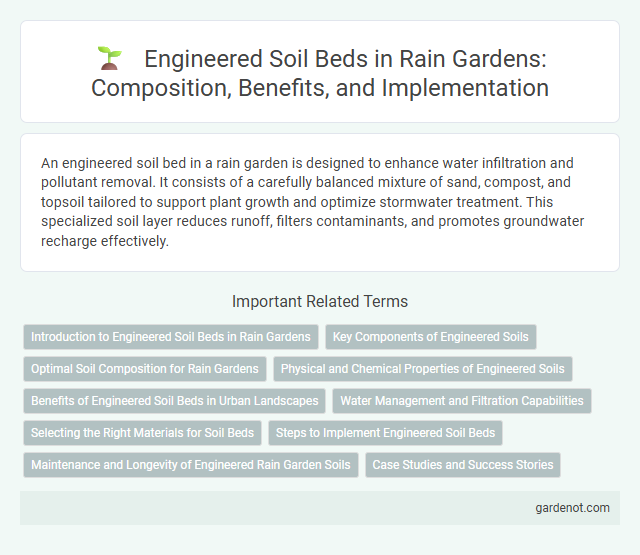An engineered soil bed in a rain garden is designed to enhance water infiltration and pollutant removal. It consists of a carefully balanced mixture of sand, compost, and topsoil tailored to support plant growth and optimize stormwater treatment. This specialized soil layer reduces runoff, filters contaminants, and promotes groundwater recharge effectively.
Introduction to Engineered Soil Beds in Rain Gardens
Engineered soil beds in rain gardens are specifically designed to enhance water infiltration, pollutant removal, and plant growth. These soil mixtures typically consist of sand, compost, and topsoil in precise proportions to balance permeability and nutrient availability. Properly engineered soil beds improve stormwater management by filtering contaminants and reducing runoff volume effectively.
Key Components of Engineered Soils
Engineered soil beds for rain gardens consist primarily of sand, compost, and topsoil, which create a balanced medium for stormwater infiltration and pollutant filtration. Optimal texture includes 60-70% sand to promote drainage, 20-30% compost to enhance organic matter and microbial activity, and 10-20% topsoil to provide essential nutrients and support plant growth. Properly graded and blended soil components ensure hydraulic conductivity rates between 1 and 6 inches per hour, supporting effective water absorption and retention while maintaining a healthy root environment.
Optimal Soil Composition for Rain Gardens
Engineered soil beds in rain gardens require a precise blend of sand, compost, and topsoil to maximize infiltration and pollutant removal. An optimal soil composition typically consists of 60% sand, 20% compost, and 20% topsoil, promoting water permeability while supporting plant health. This balanced mixture enhances nutrient cycling, reduces runoff, and improves overall rain garden performance.
Physical and Chemical Properties of Engineered Soils
Engineered soil beds in rain gardens are specifically designed to optimize water infiltration and pollutant removal through tailored physical and chemical properties. These soils typically exhibit high porosity and permeability to enhance drainage, combined with balanced texture compositions such as a mix of sand, silt, and organic matter to support microbial activity and nutrient retention. Chemical characteristics often include neutral to slightly acidic pH levels and sufficient cation exchange capacity to facilitate the adsorption of heavy metals and other contaminants, ensuring effective stormwater treatment.
Benefits of Engineered Soil Beds in Urban Landscapes
Engineered soil beds in urban landscapes enhance stormwater management by improving infiltration rates and reducing runoff, mitigating flood risks. Their optimized composition supports diverse plant growth and increases soil microbial activity, promoting urban biodiversity. These beds also improve soil structure, facilitating pollutant filtration and enhancing groundwater recharge in city environments.
Water Management and Filtration Capabilities
Engineered soil beds in rain gardens enhance water management by optimizing infiltration rates and reducing surface runoff through layered compositions of sand, compost, and topsoil. These soils are specifically designed to filter pollutants such as heavy metals, nutrients, and sediments, improving water quality before it recharges groundwater or enters stormwater systems. Properly engineered soil beds maintain moisture balance, support plant growth, and promote biodegradation processes essential for effective filtration.
Selecting the Right Materials for Soil Beds
Choosing the right materials for an engineered soil bed is crucial for effective rain garden performance. A well-balanced soil mix typically includes sand, compost, and topsoil, ensuring proper drainage, nutrient retention, and microbial activity. Using locally sourced, organic compost enhances soil structure and promotes healthy plant growth while preventing clogging and waterlogging in the rain garden system.
Steps to Implement Engineered Soil Beds
To implement engineered soil beds in rain gardens, begin by excavating the area to a depth of 18-24 inches, ensuring removal of compacted soils. Next, mix sand, compost, and native soil in proportions typically around 50% sand, 30% compost, and 20% native soil to achieve optimal permeability and nutrient retention. Finally, level the engineered soil bed and install an underdrain system if necessary to promote proper drainage and prevent waterlogging.
Maintenance and Longevity of Engineered Rain Garden Soils
Engineered soil beds in rain gardens require regular inspection to prevent compaction and maintain optimal permeability for stormwater infiltration. Incorporating organic matter and ensuring proper drainage supports microbial activity, enhancing soil structure and nutrient cycling for long-term functionality. Routine removal of debris and sediment build-up extends soil longevity and preserves the rain garden's effectiveness in managing runoff.
Case Studies and Success Stories
Engineered soil beds in rain gardens have demonstrated exceptional performance in multiple case studies, effectively reducing stormwater runoff by up to 90% and improving groundwater recharge. Success stories highlight their ability to filter pollutants, including heavy metals and nutrients, significantly enhancing urban water quality. These engineered systems combine optimized soil texture with organic matter to promote infiltration and support native vegetation growth, ensuring long-term sustainability and resilience.
Engineered soil bed Infographic

 gardenot.com
gardenot.com